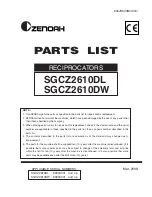
-3-
Safety Rules for Circular Saws
Do not force tool. Use the correct tool for
your application. The correct tool will do the
job better and safer at the rate for which it is
designed.
Do not use tool if switch does not turn it
“ON” or “OFF”. Any tool that cannot be
controlled with the switch is dangerous and
must be repaired.
Disconnect the plug from the power source
before making any adjustments, changing
accessories, or storing the tool. Such
preventive safety measures reduce the risk of
starting the tool accidentally.
Store idle tools out of reach of children and
other untrained persons. Tools are
dangerous in the hands of untrained users.
Maintain tools with care. Keep cutting tools
sharp and clean. Properly maintained tools,
with sharp cutting edges are less likely to bind
and are easier to control. Any alteration or
modification is a misuse and may result in a
dangerous condition.
Check for misalignment or binding of
moving parts, breakage of parts, and any
other condition that may affect the tools
operation. If damaged, have the tool
serviced before using. Many accidents are
caused by poorly maintained tools. Develop a
periodic maintenance schedule for your tool.
Use only accessories that are recom-
mended by the manufacturer for your
model. Accessories that may be suitable for
one tool, may become hazardous when used
on another tool.
Service
Tool service must be performed only by
qualified repair personnel. Service or
maintenance performed by unqualified
personnel could result in a risk of injury. For
example: internal wires may be misplaced or
pinched, safety guard return springs may be
improperly mounted.
When servicing a tool, use only identical
replacement parts. Follow instructions in
the Maintenance section of this manual.
Use of unauthorized parts or failure to follow
Maintenance Instructions may create a risk of
electric shock or injury. Certain cleaning
agents such as gasoline, carbon tetrachloride,
ammonia, etc. may damage plastic parts.
Keep hands away from
cutting area and blade.
Keep your second hand on auxiliary handle,
or motor housing. If both hands are holding
the saw, they cannot be cut by the blade. Hold
the saw firmly to prevent loss of control. Figures
in this manual illustrate typical hand support of
the saw. NEVER place your hand behind the
saw blade since kickback could cause the saw
to jump backwards over your hand.
Keep your body positioned to either side of
the saw blade, but not in line with the saw
blade. KICKBACK could cause the saw to
jump backwards. (See “Causes and Operator
Prevention of Kickback.”)
Do not reach underneath the work. The
guard cannot protect you from the blade below
the work. Do not attempt to remove cut
material when blade is moving.
Check lower guard for proper closing before
each use. Do not operate saw if lower guard
does not move freely and close instantly.
Never clamp or tie the lower guard into the
open position. If saw is accidentally dropped,
lower guard may be bent. Raise the lower
guard only with the Lower Guard Lift Lever and
make sure it moves freely and does not touch
the blade or any other part, in all angles and
depths of cut.
Check the operation of the lower guard
spring. If the guard and the spring are not
operating properly, they must be serviced
before use. Lower guard may operate
sluggishly due to damaged parts, gummy
deposits, or a buildup of debris. Disconnect the
plug from power source. Periodically remove
the blade, clean the upper, lower guards and
the hub area with kerosene and wipe it dry, or
blow it clean with compressed air.
DANGER
!
BM 2610968995 6/00 7/14/00 8:25 AM Page 3




































